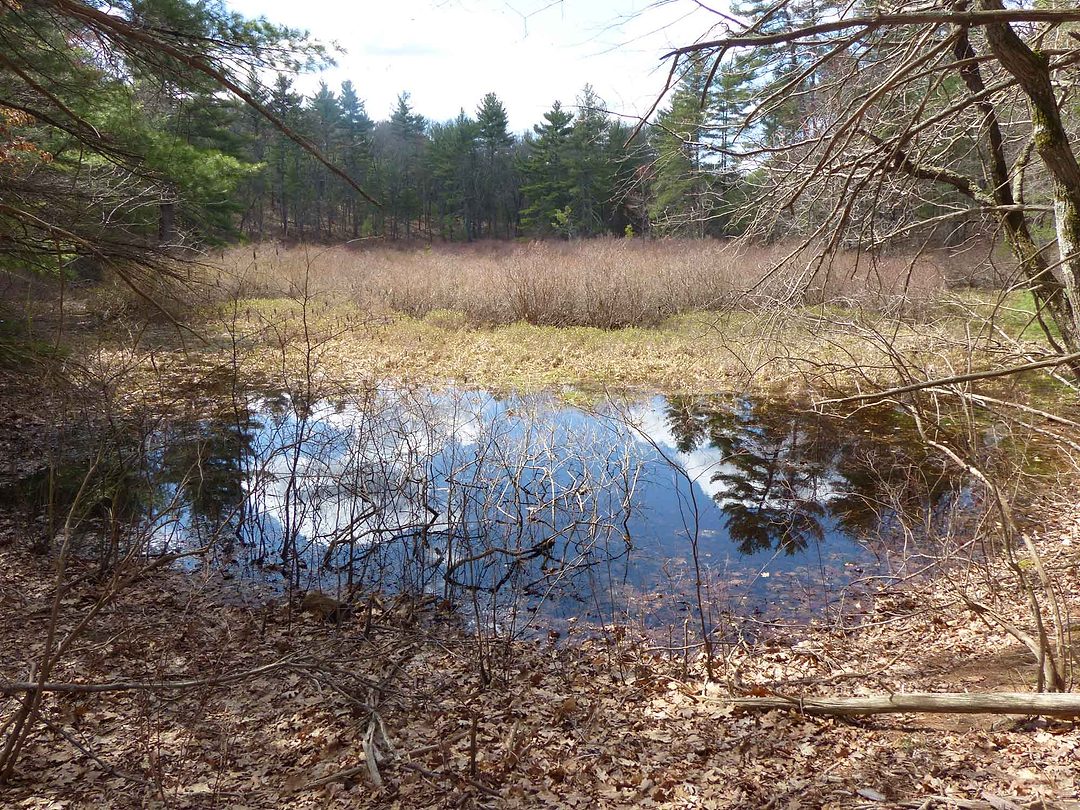To join the Walden scene, enjoy the ring-around-the-pond trail. Ever changing close-up views of the pond, its engineered pondside, and the hillside include periodic large stone steps welcoming walkers to lapping water.
But to discover nature’s ecology, explore the diverse woodland trails and special places. Here I highlight the intriguing land beyond the pond.
Don’t miss interesting species. Take an oval leaf of wintergreen groundcover, rip it in two, and smell the familiar aroma. Crow-sized pileated woodpeckers hammering tree trunks. Whitish-green pin cushion moss. Scarlet oaks color extensive areas here. To Henry Thoreau, a pre-ecology ecodetective, the scarlet oak leaf looked like a tropical isle. Large concave coves and bays with beaches for repose, alternate with rocky points and crashing waves - suitable for Vikings, buccaneers, and our sense of adventure.

Lake Walden, as depicted in an 1866 photo from the American Antiquarian Society
The big picture changing. A glacier, some 12,000 years ago, left sandy soil across the area, leading to a low water table and dry conditions for most plants. Also, insulating rock debris buried “icebergs” that later melted by geo-heat, leaving depressions where water and wet places often appear.
Extensive forest encompassed Walden through 1819. Hourglass-like, the Walden woodland shrank to a minimum by 1850 when deforestation reached the pond shore, and then forest cover expanded through 1896 and onward. Today double-trunk oaks thrive that sprouted from “mothers” of a preceding forest.

The three crowds. After two centuries of rural Walden, a thousand Irish workers with their families arrived in 1843 to construct a railway past the pond. Temporary abodes and cellar holes were dug into the hills and coves from south of the pond to today’s Route 2. The railway truncated Walden’s southwest cove and steam engines spread noise and soot particles widely.
The second crowd arrived in trainloads from Boston for a day at Lake Walden. During 1866-1902 an amusement park dominated the northwest cove, with a pavilion, oval racetrack, train station, boating area, and swimming area.
In the mid-1900s, the third crowd poured in for swimming, especially after truckloads of imported sand expanded the beach in 1957. Walden recreationists today revel in purportedly greater Boston’s best freshwater beach.
All three crowds degraded the pond water by causing eroded banks and sedimentation, nutrient and other pollutant inputs, and near elimination of the species-rich littoral zone of emergent, floating, and submerged edge vegetation. Added phosphorus, a major problem in freshwater, often catalyzes a cascade — algae blooms, green water, dead cells filtering downward, exponential growth of decay bacteria, loss of oxygen, loss of fish — leading to few fish-eating birds and anglers.

Painted turtles catching calories in spring
| ©R.T.T. FormanTo the E, S, W, and N. Eastward. Goose Pond with its peninsula trail. Busy Route 126 and its ecological impacts. Environmentally friendly visitor center area.
Southward. Excavation pit at boat launch, showing the innards of hills. Vernal pool that dries in summer — no fish predators mean amphibians may thrive. Trails atop glacial eskers with small rounded stones, one leading to Heywood’s Meadow with beaver flooding and chewed trees, even oaks; also fish, herons, and turtles. Pine woods. Emerson’s Cliff, with view (in 1850) over extensive open farmland.
Westward. Railway to Boston and Concord. Three Andromeda Ponds with water-grass-leatherleaf-tall-shrub zonation, where sphagnum moss contributes to, and thrives in, acidic conditions. Soil mounds where a grove of large live trees fell southward in a big wind.Extensive pine woods. Site of the Walden train station and amusement park.
Northward. Thoreau’s 1845-47 house site (Walden published in 1854). Marsh meadow cove. Thoreau’s beanfield site in area of huckleberry-blueberry acidic soil. Three vernal pools in glacial kettle-depressions. Area of Route 2 traffic noise eliminating sensitive birds. Extensive scarlet oak woods, with pines.
Habitats and vegetation. People create habitats, such as railbeds, concrete walls, and farm fields, that may have much lower, or higher, biodiversity than in nearby natural areas. Instead, focus on natural habitats—wetlands, ponds, rock outcrops, dry south and moist north slopes, hilltops, dead trees, and logs.
Widespread natural habitats include white pine, scarlet oak, and mixed oak woods (red, white, black and/or scarlet). Uncommon habitats, such as steep soil banks, pools, and rock outcrops, are often small with uncommon species, effectively magnets for ecologists. Wetlands appear flat, but most have enough slope, water flow, and oxygen to support marsh or swamp vegetation. Little water flow leads to acidic conditions with sphagnum moss and boggy shrubs such as leatherleaf.
Emerson’s Cliff, the only bedrock-filled hill, displays the only rock outcrop. Two uncommon conspicuous umbilicaria lichens thrive on this small, uncommon habitat.
Connecting habitats with water and wildlife. Groundwater flows from Goose Pond into Walden Pond, then slowly northwestward past vernal pools, southwestward through the Andromeda Ponds, and southward steeply down into Heywood’s Meadow. These connections through soil clean the waters.
In 2020, as in Thoreau’s day, loons summered at 100-foot-deep Walden, suggesting that populations of coldwater trout and aquatic insects were considerable. Acidic Andromeda Ponds may support some small fish, and Heywood Meadow attracts the occasional angler.
While forest shrank and men shot almost any animal they found, many species at Walden and elsewhere disappeared. Some rebounded. Today local studies find an abundance of fox, opossum, flying squirrel, mink, muskrat, beaver, painted turtle, and garter snake, plus commonly seen animals. Knowing where to optimally forage, the wildlife reduce populations of preferred foods, and create major routes tying Walden’s prime habitats together.
Discoveries waiting. Here I’ve just seen: a rotting log torn apart by a bear after grubs; tiny white woolly adelgids that decimate whole hemlock groves; two large owl pellets full of bones; very few non-native plants; and a large active beaver lodge with cozy compartments. The four square miles directly around Walden Pond hold enough uncommon habitats to support rich biodiversity. Discoveries unlimited await the walker.
Nature’s treasures lie within minutes of everyone’s home.
Illustrations courtesy of Taco I. Matthews.
With thanks to Lawrence Buell, Barbara Forman, and Dela Kaye for reviewing an earlier draft.

